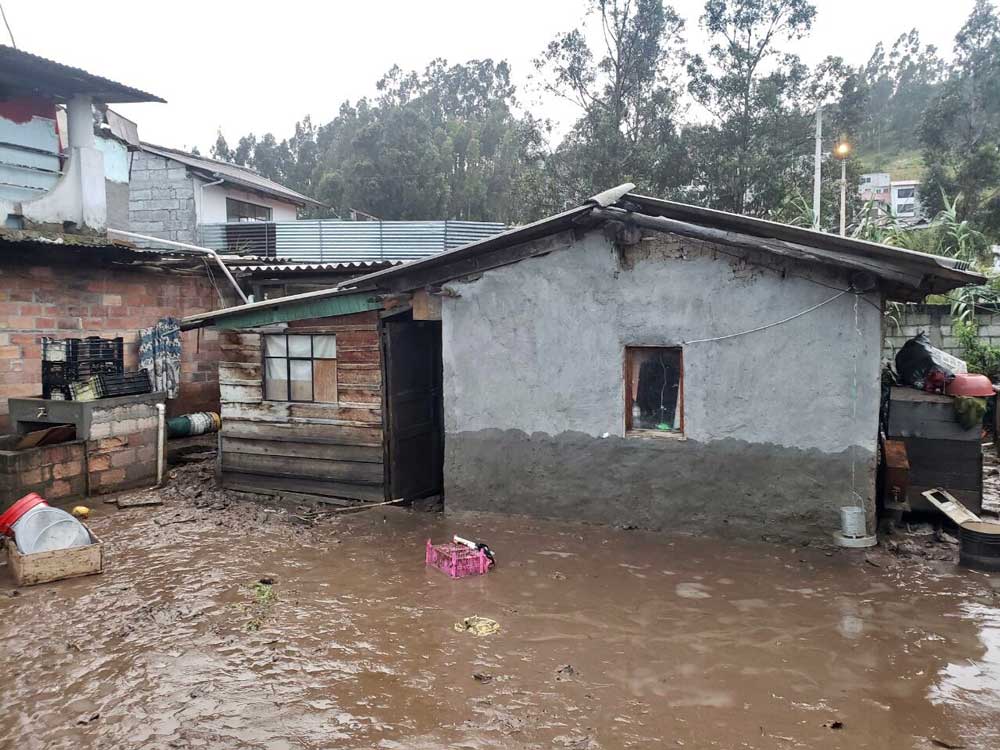During the last week of April, the winter in Cuenca has become more severe, resulting in prolonged and heavy rainfall that has led to flooding and other emergencies. It’s expected to continue thru May, albeit with reduced intensity.
In April 2023, Cuenca experienced longer and more intense rains than expected. The storms exceeded the forecasts of the Hydrometeorological Network of the Telecommunications, Drinking Water and Sewerage Company (ETAPA), causing flooding in different areas. ETAPA had forecast an accumulation of up to 20 millimeters of rain per day, but in the last week, rainfall exceeded that forecast, with an accumulation of 25 millimeters per square meter in some areas.
The intense rains have concentrated in two sectors of Cuenca, Sayausí in the northwest, and Challuabamba in the northeast, according to Rigoberto Guerrero, administrator of ETAPA’s Research and Monitoring Department. This is because there are two sources of humidity that cause the rains in Cuenca: one from the Amazon, which causes the rain in the eastern part, and the other from the Pacific Ocean, which causes the rain east of Azuay. Sometimes, the two sources of humidity meet, and it rains throughout Cuenca.
The April rains have caused flooding in various sectors of Cuenca. Among those affected are El Descanso in the north, Feria Libre in the northwest, Ricaurte in the north, Avenida de las Américas, Challuabamba in the northeast, and the Cuenca-Azogues highway in the north.
Since Tuesday, April 25, the Cuenca Fire Department has attended dozens of emergencies throughout the city due to water accumulated in houses and roads. In Cuenca, there are about 20 points susceptible to flooding, according to information from the Municipal Risk Unit and the Land Management Plan.
Flooding a combination of natural phenomena and human actions
Cuenca has four main rivers: Tomebamba, Machángara, Tarqui, and Yanuncay. The last two are the ones that have caused the most overflow pre-alerts in April. Guerrero explains that the Tarqui and Yanuncay basins are the most susceptible to sudden flooding, making it more likely that there will be flooding. In the Tarqui river, there is an alteration of the natural channel made by the population in the past, and every year, the plains of that parish are flooded. Along the Yanuncay, rockfills have been carried out on the banks to mitigate the overflows, but they have not given results. Some have even been counterproductive.
Although Cuenca is susceptible to flooding because it is crossed by four large rivers, there are also other causes that condition these emergencies, most of which have to do with human interventions. These include a lack of cleaning of drains, covered ravines, alteration of the banks and riverbeds, and deforestation.
An example of this is what happens in El Descanso, on the border between Azuay and Cañar, where flooding was not common. However, in the last four years, every heavy rain has collapsed the sector. In April 2023 alone, two floods occurred in El Descanso, and the last one was at dawn on Thursday, April 27, where firefighters worked for several hours to rescue 10 people who were trapped in three vehicles.
Sixto Heras, head of the Cuenca Fire Department, explained that there is a problem in this sector due to the exploitation of aggregates. Garbage and sand clog the vents, and the water has nowhere to drain. When it rains very intensely, the water that accumulates on the road is greater than the river’s discharge capacity, according to Heras. When firefighters go to floodwaters, they find clogged drains, clogged ditches and water channels, as well as filled creeks.
Another factor contributing to the floods is deforestation, which alters the natural balance of the ecosystem. Trees play an important role in preventing soil erosion and regulating the flow of water, but the destruction of forests for human activities such as agriculture, mining, and urbanization has significantly increased the risk of flooding.
According to Guerrero, the current situation in Cuenca is a combination of natural phenomena and human actions. He emphasized that while the rainfall intensity is beyond human control, steps can be taken to mitigate its impact. These include cleaning drains and waterways, regulating urbanization and land use, and implementing measures to preserve forests and natural habitats.
Mitigation plan
The Cuenca municipal government has implemented a contingency plan to address the current flooding situation. This plan involves the coordination of various government agencies, such as the Municipal Risk Unit, the Fire Department, and the National Police, to respond to emergencies and assist affected communities.
ETAPA has also taken measures to mitigate the impact of the floods on its infrastructure, such as increasing the capacity of water reservoirs and diverting water flows to prevent damage to water treatment plants.
In addition, the government is working on a long-term solution to prevent flooding in Cuenca.
This includes the implementation of a comprehensive urban planning strategy that considers the natural topography and hydrology of the area, as well as the adoption of sustainable land use practices and the preservation of natural habitats.
While the current flooding situation in Cuenca is a cause for concern, it also highlights the need for greater awareness and action to address the underlying factors contributing to it. By working together to address these challenges, Cuenca can build a more resilient and sustainable future for its residents.


0 Comments